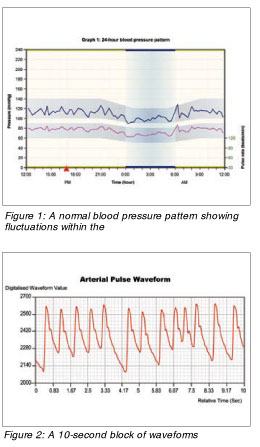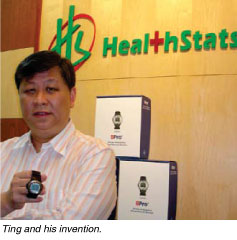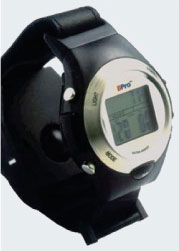|
by Lay Leng TAN
 ardiovascular disease accounts for about 30% of all deaths worldwide. According to a report by Lancet in 2005, nearly one-third of the world's adult population will suffer from hypertension by 2025. More disturbing than this alarming figure is the fact that these lethal cardiovascular problems sometimes show no symptoms. ardiovascular disease accounts for about 30% of all deaths worldwide. According to a report by Lancet in 2005, nearly one-third of the world's adult population will suffer from hypertension by 2025. More disturbing than this alarming figure is the fact that these lethal cardiovascular problems sometimes show no symptoms.
Many recent cases of young adults dying suddenly at night or while exercising have highlighted this increasingly worrisome trend. Arrhythmia or irregular heartbeat contributes to such deaths, often from heart attacks. Although heart-rate variability provides the closest indicator of arrhythmia, it usually provides no warning signs and defies easy detection. Presently, it seems that the mean arterial pressure (MAP) provides a strong indicator of stroke whereas pulse pressure forewarns a heart attack. However, latest studies have shown that a stronger index called Central Aortic Pressure (or the pressure at the root of the aorta) is a very powerful parameter for both prediction and prognosis of stroke and heart disease.
Detecting Heart Irregularity
Managing hypertension based on clinical blood pressure (BP) readings, the most common approach, can lend a false sense of security. A quick explanation of the heart function illustrates why. Heartbeat essentially constitutes a mechanical function of the pumping heart. The organ also emits an electrical signal that an electrocardiograph (ECG) machine detects to observe heartbeat pattern. Very often the signals may appear all right, but the mechanical portion that reflects the pumping heart could be abnormal -- a condition known as electrical-mechanical dissociation. A seemingly healthy person can actually have a small pumping abnormality or arrhythmia an ECG cannot pick up.
Studies show that ambulatory blood pressure monitoring (ABPM) and arterial pulse waveform study correlate with the morbidity of patients with cardiovascular disease, and medical intervention can help improve their outcome. ABPM, which gives a macroscopic or broad view of BP pattern only, faces such limitations as cost, comfort (cuff pumping on the arm every half hour for 24 hours), and convenience.
The subtler arterial waveform monitoring provides a more micro and accurate view of BP, but no suitable device yet exists in a clinical setting. Researchers currently employ the Sphymacor system (US$32,000) and Portapress (US$40,000) in laboratories and hospitals for hypertensive study. The price tag obviously puts the equipment out of the reach of general practitioners who manage some 90% of hypertensive patients. Although both these methods provide invaluable information on the status of the arterial health as in the form of a 24-hour pattern and stiffness of the arterial tree as in the pulse waveform analysis, they do not reflect any form of arrhythmias. Furthermore, these devices are expensive and not easily available to the common general practitioners.
A physician in Singapore has come up with an innovation that answers these needs.
Choon Meng Ting, frustrated with the limitations of the current clinical measuring equipment, conducted intensive research and came up with technology that can measure and show the risk of asymptomatic irregular heart beat in a clinical setting. Ting, chairperson and CEO of HealthSTATS International Pte Ltd, set up the company in 2000 to convert his research findings into a product.
Years of hard work and dogged perseverance resulted in BPro, a watch-like device for recording blocks of arterial waveform over time to record the pumping action of the heart. It uses a modified form of applanation tonometry based on the principle of slightly flattening a part of the body, such as an eyeball, to measure opposing pressure.
 BPro can pick up heart variability by sampling the pulse 60 to 100 times per second. By tracking the blocks of arterial pulse waveforms every 15 minutes for a full 24 hours, the calibrated data show both the blood pressure fluctuations over the period, allowing doctors to track and study the variability of the heart rate in all these blocks. A-Pulse, a proprietary software developed by HealthSTATS, also enables waveform analysis, accurately producing the Central Aortic Pressure (CAP), the Central Pulse Pressure (CPP), and other standard indices for arterial stiffness. BPro can pick up heart variability by sampling the pulse 60 to 100 times per second. By tracking the blocks of arterial pulse waveforms every 15 minutes for a full 24 hours, the calibrated data show both the blood pressure fluctuations over the period, allowing doctors to track and study the variability of the heart rate in all these blocks. A-Pulse, a proprietary software developed by HealthSTATS, also enables waveform analysis, accurately producing the Central Aortic Pressure (CAP), the Central Pulse Pressure (CPP), and other standard indices for arterial stiffness.
In fact, to show the effectiveness of such occurrence, HealthSTATS has started a screening programme with the Brain and Stroke Centre in Singapore General Hospital (SGH), whereby newly admitted patients for strokes were routinely put on the BPro for both 24-hour monitoring and pulse waveform analysis through A-Pulse. Initial analysis of 130 patients showed that about 40% have a non-dipper pattern in 24 hours. A non-dipper pattern is the difference in the mean blood pressure of less than 10% between the daytime and nighttime hours.
More significantly, the device captured a number of patients with arrhythmias -- such as previously undiagnosed atrial fibrillations (AF) or abnormal heart rhythm in the upper heart chambers -- on subsequent ECG tracing. Others were not even detected at all, showing signs of ˇ°intermittent AF.ˇ± Anticoagulation could have prevented an episode of stroke instead of blaming the patients for non-compliance of medications. The ongoing trial will continue for a year.
Both Singapore and UK researchers have independently validated CAP and CPP derived from BPro with the gold standard, showing an accuracy of less than 0.7mmHg in mean difference. HealthSTATS has submitted A-Pulse for the US Food and Drug
Administration (FDA) listing. The greatest advantage of this innovation is the elimination of the General Transfer Function previously required when using the radial waveforms at the wrist. This means CAP and CPP can now be easily available to the common practitioners in normal clinical setting.
BPro behaves like an airplane's black box, recording heart rate and arterial waveforms over 24 hours. Figure 1 shows a patient's sample BP pattern, which appears normal. However, when broken down into individual readings (blocks of 10-second waveforms as in Figure 2), the chart reveals an irregular heart rate that indicates arrhythmia, which can lead to stroke or even death. In a worst-case scenario, if a person wearing the BPro dies, the playback can show what happened before he or she collapsed.
Unlike other methods, the BPro does not restrict movement or disrupt sleep. It is the only device in the world to take a person's blood pressure without the wearer being aware of its presence. This extremely important feature, explains Ting, effectively removes the so-called white-coat effect when using a cuff-and-pump method. An ABPM using a cuff or pump for BP measurement causes discomfort to the wearer and may evoke an anticipatory effect that raises the blood pressure.
Recognition
HealthSTATS has filed no less than 10 patents worldwide. In recognition of the BPro's innovativeness, the Swiss-based World Economic Forum presented Ting with a Technology Pioneer award for 2007, a Singapore first. The endorsement dovetails the company's S$11.5 million fund raised from Singapore venture capitalist WhiteRock Partners and private investors, as well as lowering entry barriers to the product in various countries.
 BPro has already received the European CE-MDD Mark and FDA listing. It has also received certification for the Australian and New Zealand markets, as well as for China. Furthermore, the independent Clinical Trials and Epidemiology Research Unit in Singapore has validated the device as compliant with the protocols set by the Association for the Advancement of Medical Instrumentation and European Society of Hypertension. BPro has already received the European CE-MDD Mark and FDA listing. It has also received certification for the Australian and New Zealand markets, as well as for China. Furthermore, the independent Clinical Trials and Epidemiology Research Unit in Singapore has validated the device as compliant with the protocols set by the Association for the Advancement of Medical Instrumentation and European Society of Hypertension.
As mentioned, the SGH stroke trial involving 200 patients will be expanded to some 1,000 patients over the next year. Researchers are currently using the company-developed algorithm for BPro to predict the waveforms in the carotid artery and middle cerebral artery. This will eventually develop into indices that can allow doctors to effectively track and monitor the treatment of such stroke patients.
HealthSTATS also collaborates with the Nanyang Technological University in Singapore and Beijing University to predict risks from stroke in about 1,000 hypertensive and normal adults in Singapore and China over a two-year period. Researchers upload collected data into the computer, and HealthSTATS' software plots the BP pattern and derives medically relevant parameters to diagnose hypertension more accurately.
In Singapore, the National Heart Centre has acquired BPro. HealthSTATS has also formed partnerships with Asia Medic and Thomson Medical Centre to provide the device as a screening service. This arrangement aims to reduce capital outlay while reaching out to more users. The company hopes to become the outsourcing provider of ABPM services in Singapore among the government and private healthcare givers.
Services rolling out in stages involve other countries such as Hong Kong, China, Malaysia, the Philippines, Australia, New Zealand, the UK, the Netherlands, Belgium, Luxembourg, and Switzerland. The company has targeted Korea, Japan, Taiwan, Middle East, and the US in 2007.
People who prefer to remain anonymous -- politicians, Middle Eastern royalty, and celebrities -- have used the BPro. This group's word-of-mouth recommendation may spur more people to acquire the device.
Future Development
In the HealthSTATS pipeline are consumer products based on its core technology, the Evidence-based Blood Pressure monitoring. A portable prototype in phase 2 allows patients to wear it and wirelessly transmit their data through mobile phones to doctors anywhere in the world for analysis and advice. Another device looks at arrhythmia and heart rate variability. Detection of any abnormality will serve as a warning for possible heart risks. The company has completed the proof-of-concept stage and first-generation prototypes are in development for further validations.
Besides developing a device for the leg, HealthSTATS' biggest potential gold mine lies in the growing data collected over time. The company eventually plans to analyse the information and learn the effects and efficacies of drugs. This will have major implications for researchers, pharmaceutical companies, healthcare providers, and even governments.
|
Applanation Tonometry
When the heart pumps blood through an artery, internal pressure presses the wall out; circumferential pressure bounces the artery back. When a tonometer presses on an artery, it removes circumferential pressure such that only the intra-luminal pressure within the artery remains. Thus, the device can completely feel arterial pressure on the outside of the vessel -- or applanation.
Modified applanation tonometry developed by HealthSTATS uses raw data from the arterial waveforms. It can show stiffening of the artery and the effects of different blood-pressure-lowering drugs.
For accurate measurements, three circumstances must exist: first, the artery must rest on a hard surface, such as a bone, on the far side; second, the portion under compression between the skin and the artery should have minimal tissue or fat; and third, cholesterol plaque must not have affected the artery.
The radial artery at the wrist presents the ideal site -- the artery has a bone behind it, it has hardly any fat covering it, and plaque does not affect it. In fact, surgeons frequently use this artery in heart bypass procedures, thanks to the last property.
BPro Design Innovation
 BPro comprises three main parts: the watch and strap that collect the signals and fix the position of the sensor; the algorithm and the circuitry that analyse the waveforms; and an intelligent computer that filters out abnormal waveforms to get a good recording. BPro comprises three main parts: the watch and strap that collect the signals and fix the position of the sensor; the algorithm and the circuitry that analyse the waveforms; and an intelligent computer that filters out abnormal waveforms to get a good recording.
HealthSTATS circumvents the problem of sensor placement by designing a hemispherical plunger that provides a comfortable feel and, more importantly, measures pulse pressure amplified at the plunger's centre . The plunger also avoids a nerve near the wrist, vulnerable to damage from prolonged contact, as in carpal tunnel syndrome.
The plunger houses a sensor made of double-layer silicon with a well containing silicon gel. The well transmits the pressure, and the circuit behind has a die that equilibrates with atmospheric pressure. Based on the piezoelectric principle, an electrical current changes the resistance of the circuit with changing pressure on the sensor, allowing extraction of the signal at a very high sampling rate.
The biggest challenge lies in fixing the sensor on the wrist to get a constant pressure while allowing the hand to move freely. HealthSTATS solves this problem by designing three-point anchoring for stability -- a sliding strap for the watch that glides over the sensor in the plunger and bypasses it, with padding at the watch head to prevent motion.
Besides the hardware, much thought also went into software development. An intelligent program analyses the circuitry, recognising and extracting relevant waveforms at high-sampling rates to obtain a valid pattern of the heartbeat over 24 hours. Delay peak gate circuitry and a microprocessor mimic the heart's electrical pulse to capture the waveform, validation, calculations, and detailed analysis faithfully. The BPro software prints out the analysis of the 24-hour blood-pressure pattern (macro-analysis) plus the waveform analysis (micro-analysis). For security reasons and licensing purposes, the designers added different mechanisms and safety features.
|
 Click here to download the full issue for USD 6.50 Click here to download the full issue for USD 6.50
|


 ardiovascular disease accounts for about 30% of all deaths worldwide. According to a report by Lancet in 2005, nearly one-third of the world's adult population will suffer from hypertension by 2025. More disturbing than this alarming figure is the fact that these lethal cardiovascular problems sometimes show no symptoms.
ardiovascular disease accounts for about 30% of all deaths worldwide. According to a report by Lancet in 2005, nearly one-third of the world's adult population will suffer from hypertension by 2025. More disturbing than this alarming figure is the fact that these lethal cardiovascular problems sometimes show no symptoms.
 BPro can pick up heart variability by sampling the pulse 60 to 100 times per second. By tracking the blocks of arterial pulse waveforms every 15 minutes for a full 24 hours, the calibrated data show both the blood pressure fluctuations over the period, allowing doctors to track and study the variability of the heart rate in all these blocks. A-Pulse, a proprietary software developed by HealthSTATS, also enables waveform analysis, accurately producing the Central Aortic Pressure (CAP), the Central Pulse Pressure (CPP), and other standard indices for arterial stiffness.
BPro can pick up heart variability by sampling the pulse 60 to 100 times per second. By tracking the blocks of arterial pulse waveforms every 15 minutes for a full 24 hours, the calibrated data show both the blood pressure fluctuations over the period, allowing doctors to track and study the variability of the heart rate in all these blocks. A-Pulse, a proprietary software developed by HealthSTATS, also enables waveform analysis, accurately producing the Central Aortic Pressure (CAP), the Central Pulse Pressure (CPP), and other standard indices for arterial stiffness.
 BPro has already received the European CE-MDD Mark and FDA listing. It has also received certification for the Australian and New Zealand markets, as well as for China. Furthermore, the independent Clinical Trials and Epidemiology Research Unit in Singapore has validated the device as compliant with the protocols set by the Association for the Advancement of Medical Instrumentation and European Society of Hypertension.
BPro has already received the European CE-MDD Mark and FDA listing. It has also received certification for the Australian and New Zealand markets, as well as for China. Furthermore, the independent Clinical Trials and Epidemiology Research Unit in Singapore has validated the device as compliant with the protocols set by the Association for the Advancement of Medical Instrumentation and European Society of Hypertension.
 BPro comprises three main parts: the watch and strap that collect the signals and fix the position of the sensor; the algorithm and the circuitry that analyse the waveforms; and an intelligent computer that filters out abnormal waveforms to get a good recording.
BPro comprises three main parts: the watch and strap that collect the signals and fix the position of the sensor; the algorithm and the circuitry that analyse the waveforms; and an intelligent computer that filters out abnormal waveforms to get a good recording.
 Click here to download the full issue for USD 6.50
Click here to download the full issue for USD 6.50